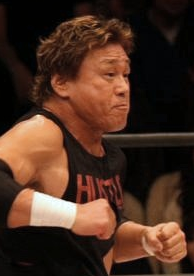History
All Japan Pro Wrestling (AJPW) was founded in 1972 by Shohei "Giant" Baba, Mitsuo Momota, and Yoshihiro Momota; the three were a student and the two sons of Rikidōzan, the godfather of Japanese professional wrestling a.k.a. Puroresu. Baba served as the promotion's president, head booker, talent scout, and head trainer for much of his lifetime. Under Baba, the promotion enjoyed much success and reached new heights in the 1990s thanks mostly to the performances of Mitsuharu Misawa, Toshiaki Kawada, Kenta Kobashi, and Akira Taue--dubbed "The Four Pillars Of Heaven" by magazines and reporters. Baba continued to run the promotion until late 1998 when his health deteriorated and he was hospitalized in January 1999.
Build-up
Baba died from liver failure (a complication of colon cancer) on January 31, 1999, at the age of 61. [1] In the wake of his death, widow and majority shareholder [2] Motoko Baba intended for Mitsuo Momota to inherit the presidential position, [3] but board member Jumbo Tsuruta used his influence to help Misawa inherit the position, before Tsuruta himself was forced out of the company (with no severance package). [3] [4] Misawa was trained for the position during the following months, [5] and was officially announced as AJPW president during a press conference on May 7. [6]
Disagreements with Motoko Baba arose even before the transition was made public, as reports of a "quiet" power struggle saw print in March 1999, [5] and Tsuruta confirmed these when he left Japan for Portland, Oregon. [7] In fact, the two had had professional tensions long beforehand. Motoko had opposed the decision to push Misawa in the wake of Genichiro Tenryu's departure in 1990, [8] and the two began conflicting as early as 1996; in the year before Shohei Baba's death, Misawa even asked him on behalf of the locker room to have his wife leave the company, and was somewhat successful in that she ceased to have any creative influence when Misawa began booking. [10] [11] Misawa attempted to keep Baba content by maintaining the same salary that she had been paid when her husband was alive (approximately $500,000), but this did not change the power dynamic. [4] Misawa's wish to change the AJPW product, and to modernize its presentation, to address their box office troubles ran in direct opposition to Baba's intent to maintain her late husband's booking philosophy. [4] Misawa was particularly intent on pushing the company's younger talent, and in September 1999 he and Baba had a major fight over a match between Jun Akiyama and Takao Omori being the main event of a Budokan show (which sold out), although this match's placement had been decided by a fan ballot. [4] [12] Motoko's conservatism was partially due to her belief that the company, and Japanese wrestling as a whole, had fallen from its peak. [3] Misawa was also angry with Motoko over fiscal matters, as he had discovered that much of the company's merchandise sales did not produce funds for AJPW, but for a subsidiary that she had set up. At some point, Misawa approached Nippon TV with his plans to leave AJPW to start a new promotion, and told them that nearly everyone in the locker room would follow him. NTV officials told Misawa that they supported him, but that they needed to keep their agreement quiet for the time being as, due to the proximity of Baba's death, the station wanted to wait until enough time had passed to drop All Japan's television program, which had been associated closely with NTV since its formation. [15] [3] [16] Nevertheless, rumors that NTV had taken Misawa's side in his dispute against Baba saw print in February 2000, and Weekly Fight Magazine reported that AJPW would split into two groups in May, though Misawa declined to comment on this. [17] [18]
Adding to the situation was that, as of the end of the fiscal year on March 31, 2000, all the promotion's talent were working as free agents, since Misawa was not authorized to give the raises he intended to award all native workers; Misawa had also wanted to modernize their contracts, providing wrestlers with full medical coverage, full injury pay, and possibly stock options (which NJPW's contracts offered). [4] As the result of these disagreements, [19] the AJPW executive board voted to remove Misawa from the presidential position on May 28. [20] All parties agreed to keep this news private until the end of the current tour, and Misawa attempted to persuade Baba to give him her public blessings to start a new company, so as to smooth the public transition and preserve the legacies of Giant Baba and the recently deceased Tsuruta. [4] Baba refused this proposal or relinquishment of any of her majority share, and Tokyo Sports broke the news on June 12. [4] At an emergency board meeting held in response on June 13, co-vice president Mitsuo Momota and fellow boardsmen Kobashi, Taue, Kenichi Oyagi, and Yoshihiro Momota collectively resigned from their positions. [4]


